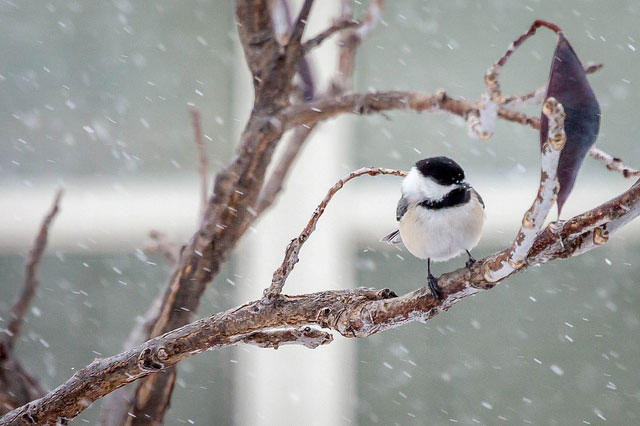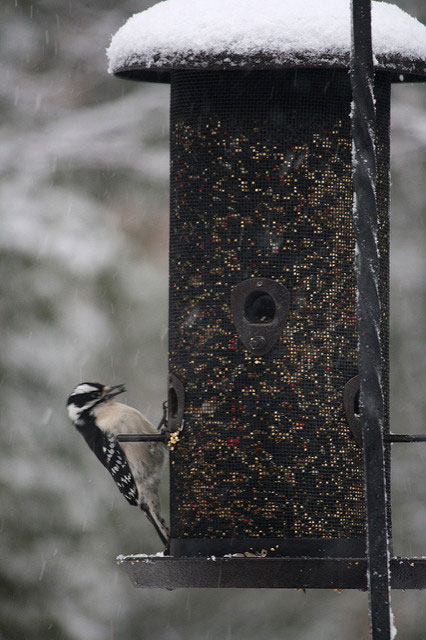
How Do Small Birds Survive a Long Winter?
By Stan Temple
Ever wonder how the black-capped chickadee and other small birds survive a long winter? Small birds are at a particular disadvantage during winter cold because they lose body heat to the environment much faster than larger birds.

Still, many small birds do cope successfully with winter — a feat they accomplish through physical, physiological, and behavioral mechanisms.
Their fundamental challenge: to maintain body temperature by increasing the production, and reducing the loss, of body heat.
Survival tactic one: Produce body heat
Birds produce body heat in several ways, but the primary one is through production of metabolic heat from food. In this way, birds can boost their basic metabolic rate several-fold when it’s cold and heat loss from the body is unavoidable.
Foods rich in calories allow birds to produce the most body heat, and foods containing fats and carbohydrates are the best sources. That’s why birds at your bird feeder are especially attracted to items like sunflower seeds and suet, which provide the most calories per item consumed.

Even when consuming rich foods, however, birds need to eat more to keep fueling extra metabolic heat production. This is why in cold weather small birds spend almost all their waking hours finding and consuming rich food.
That’s a real challenge in winter when food is scarce and daylight hours are short. But all that extra activity produces more body heat than if birds were sitting still. And when it’s necessary to ramp up the production of body heat even further, birds can shiver.
There is a limit, though: Birds can only ramp up production of metabolic heat so much to counterbalance the loss of body heat to the cold environment. If body heat begins to drop, birds can suffer hypothermia, putting them at serious risk of dying.
This is where the second strategy becomes important: conserving body heat.
Survival tactic two: Conserve body heat
The second way small birds maintain their body temperature in winter is by conserving the precious metabolic heat they’ve produced. The primary way small birds reduce heat loss is through insulation. Feathers provide excellent insulation, and when it’s cold, birds can fluff up their feathers to reduce heat loss further. Some birds even add extra feathers in winter.
But wind can ruffle feathers, allowing cold air to reach the body. So birds try to avoid windy places as much as possible. Keeping feathers dry is also important as wet feathers don’t provide good insulation.
When they’re not on the go, another tactic birds employ is to tuck bare feet and bills into their feathers to reduce heat loss from these un-feathered surfaces. Reducing heat loss is especially critical at night when birds have to maintain their metabolism using fat stored in their bodies during the previous day’s foraging.

Small birds actually gain weight each day and lose weight overnight, repeating the cycle of weight gain and loss each day. At night small birds typically conserve heat by roosting in a confined space, like a cavity, which shelters them from the cold, damp, and wind, and provides additional insulation.
Huddling is another tactic many small birds use to conserve heat at night when several birds will share the same shelter.
In his essay “65290” in A Sand County Almanac, famed conservationist Aldo Leopold wrote: “It seems likely that weather is the only killer so devoid of both humor and dimension as to kill a chickadee. I suspect that in the chickadee Sunday School two mortal sins are taught: thou shalt not venture into windy places in winter, and thou shalt not get wet before a blizzard.”
You can help chickadees and other small birds survive a long winter if your healthy woods provide the essential food and shelter they need to produce and conserve body heat.
Natural tree cavities and artificial nest boxes can provide critical nighttime shelter, while bird feeders, abundant wild seeds, and overwintering insects provide energy.
If all goes well, enough individuals will survive to breed in the spring and replace inevitable overwinter losses.
University of Wisconsin emeritus professor and wildlife expert, Stan Temple, writes and speaks frequently about birds, wildlife ecology, and conservation. Contact him at satemple@wisc.edu.
